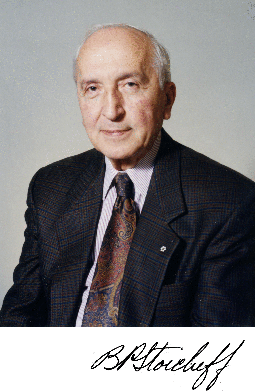Boris P. Stoicheff facts for kids
Quick facts for kids
Boris P. Stoicheff
|
|
|---|---|

Boris P. Stoicheff
|
|
| Born |
Boris Peter Stoicheff
June 1, 1924 |
| Died | April 15, 2010 (aged 85) |
| Nationality | Macedonian |
| Citizenship | Canadian |
| Education | University of Toronto (Ph.D. 1950) |
| Awards | William F. Meggers Award (1981) Frederic Ives Medal (1983) Henry Marshall Tory Medal (1989) |
| Scientific career | |
| Fields | Physics |
| Institutions | National Research Council (Canada) University of Toronto |
| Thesis | Raman spectroscopy of gases at high pressures (1950) |
| Doctoral advisor | Harry Lambert Welsh |
| Other academic advisors | Gerhard Herzberg (Post doctoral advisor) |
Boris P. Stoicheff was a very important Canadian physicist. He was born on June 1, 1924, and passed away on April 15, 2010. He made amazing discoveries about how light works. His research helped us understand tiny particles and how they behave.
He was known for his work with light and how it interacts with different materials. This field is called physics.
Early Life and Education
Boris Stoicheff was born in a town called Bitola. This town was in the Kingdom of Yugoslavia. Today, it is part of North Macedonia.
In 1931, when Boris was seven, his family moved to Canada. He grew up in the city of Toronto. He went to the University of Toronto for his studies. In 1947, he earned a degree in Engineering Physics. He continued his studies there and received his PhD in 1950.
After his PhD, he spent another year at the University of Toronto. Then, he moved to Ottawa to work at the National Research Council (Canada). He joined a special lab that studied spectroscopy. This is a way to study materials by looking at how they interact with light. The lab was led by a famous scientist named Gerhard Herzberg.
Boris worked as a researcher in this lab. He focused on something called Raman scattering. This is when light changes its energy after bouncing off molecules. In 1953, he became a permanent researcher at the National Research Council.
Scientific Discoveries
In the 1950s, Boris Stoicheff became very famous for his work. He used Raman spectroscopy to study molecules. This method helped him see details about molecules that no one had seen before. He published many important findings.
In 1954, Boris married his wife, Joan. They had a son named Peter Stoicheff in 1956. Peter later became the President of the University of Saskatchewan.
Later in the 1950s, Boris became interested in Brillouin scattering. This is another way light interacts with materials. He also tried to build a laser. A laser is a device that makes a very strong, focused beam of light. Another scientist, Theodore Maiman, built the first working laser. But Boris Stoicheff soon built the first laser in Canada! He then used it for his spectroscopy research.
In 1963, he spent a year at MIT in the United States. He worked with Charles Townes, another famous scientist, and his students. They researched how to use lasers for spectroscopy. In 1964, Boris became a professor at the University of Toronto.
In the late 1970s, he started studying Rydberg spectroscopy. This is about how atoms behave when their electrons are in very high energy states. He retired in 1989 but kept doing research. By the year 2000, he was studying the mysterious diffuse interstellar bands. These are dark lines seen in light from space.
Honors and Awards
Boris Stoicheff received many important awards for his work:
- In 1975, he was chosen as a Fellow of the Royal Society. This is a very high honor for scientists in the United Kingdom.
- He was the president of the Optical Society of America in 1976.
- He received the William F. Meggers Award in 1981.
- He was given the Frederic Ives Medal in 1983.
- In 1989, he received the Henry Marshall Tory Medal.
Tributes
Since 2011, there is a special scholarship named after Boris Stoicheff. The Optical Society of America and the Canadian Association of Physicists offer this award every year. It goes to a university student who is excellent in research and helps out in scientific groups.
See also
- Inverse Raman effect
- Stimulated Brillouin scattering
- Singlet fission
- Supercontinuum

